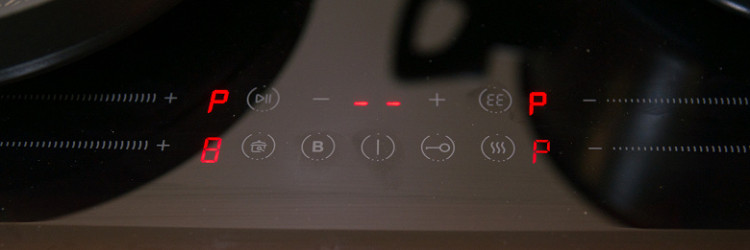The full-size History HI 6440 BBK induction hob features four heating zones and individual touch controls for each burner. It offers 9 power levels and the ability to activate the Boost mode.
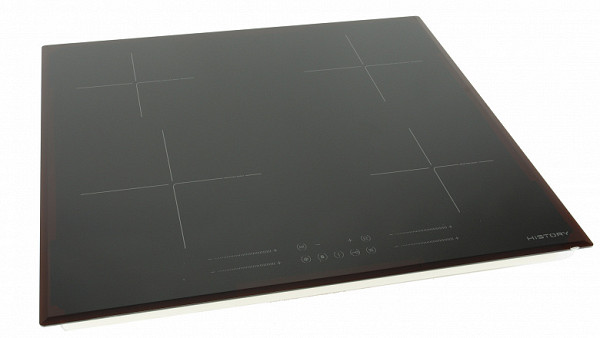
The device includes standard functions such as timer, pause and lock, as well as several additional features: Smart Zone, Fondue and the Cookware Quality function, which automatically evaluates the efficiency of the panel depending on the quality of the cookware used. During the test, we will consider all these options, prepare several standard dishes and evaluate the convenience and efficiency of the panel.
Characteristics
| Manufacturer | History |
|---|---|
| Model | HI 6440 BBK |
| Type | Built-in induction hob |
| Country of origin | China |
| Guarantee | 24 months |
| Service life* | 7 years |
| Total power | 7200 W |
| Number of burners | 4 (210 mm, 180 mm and 2×160 mm) |
| Number of power levels | 9 + Boost |
| Burner power | 210 mm — 2300/3000 W, 180 mm — 1800/2100 W, 160 mm — 1200/1500 W |
| Control | sensory |
| Surface material | glass ceramics |
| Peculiarities | overheating protection, auto power off, cookware presence detection, timer, pause, lock, Fondue/Keep Warm mode, Smart Zone functions and determination of the energy efficiency of the cookware used |
| Length of cord without plug | 1.2 m |
| Net weight | 8.5 kg |
| Dimensions (W×D×H) | 590×520×58 mm |
| Niche size for installation | 560×490 mm |
* Contrary to popular belief, this is not a period after which the device will necessarily break down. However, after this period, the manufacturer ceases to bear any responsibility for its functionality and has the right to refuse to repair it, even for a fee.
Equipment
The History HI 6440 BBK hob arrived for testing in a sturdy brown cardboard box. The packaging featured the manufacturer's logo, various shipping marks, and a sticker with information about the model and manufacturer.
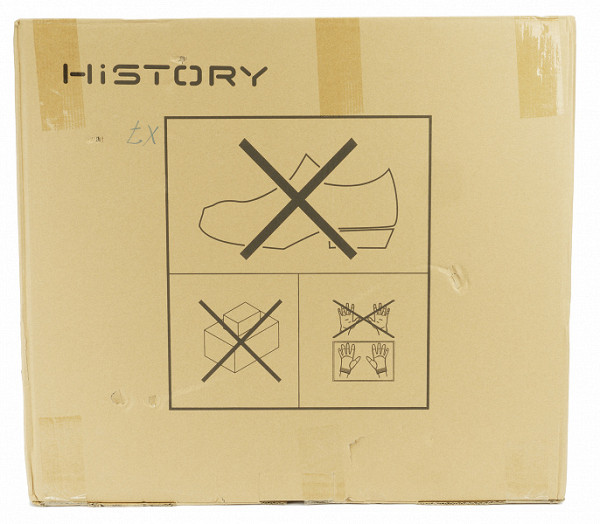
After opening the box and removing the foam «airbags,» we found the panel itself, an electrical cord without a plug, damper tape, a set of metal staples, and an instruction manual.
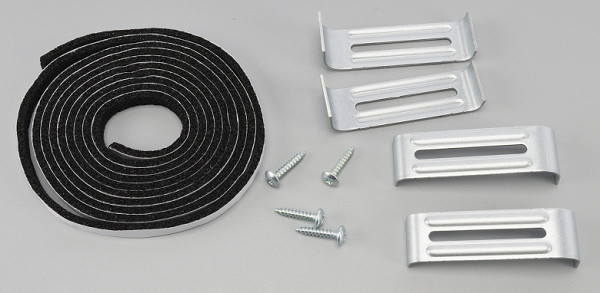
At first glance
The glossy surface of the hob is made of Kanger Ceramic Glass. According to the manufacturer, this coating is highly hard, resistant to thermal fluctuations and scratches from dishes, and can withstand temperatures up to 750 degrees.
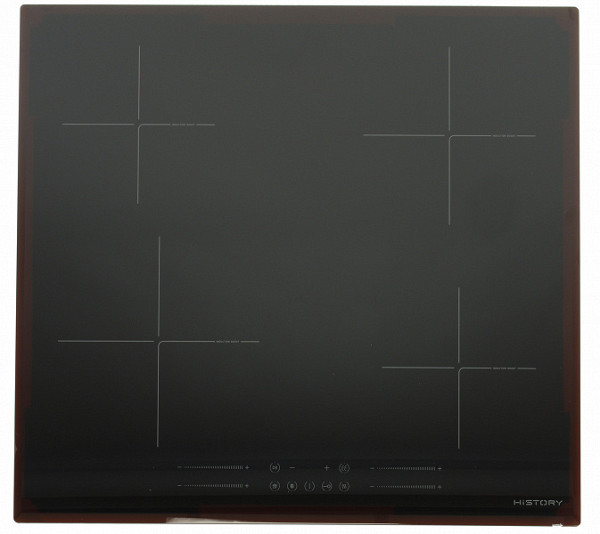
The design of this frameless model with beveled edges can be considered a modern classic. The device looks elegant, and at first glance, the quality of the coating and assembly of the case left a positive impression.
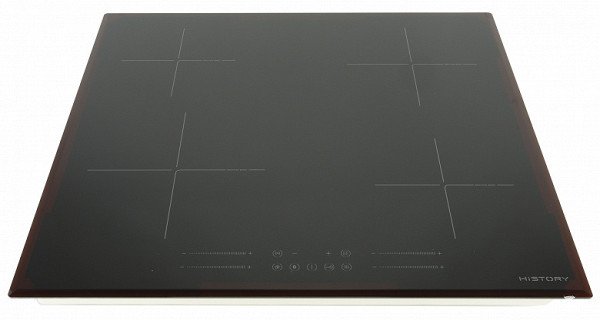
Four heating zones are highlighted on the perfectly smooth deep black surface. The touch control panel is located in the usual lower part in the center, and in the far right corner there is a brand logo.
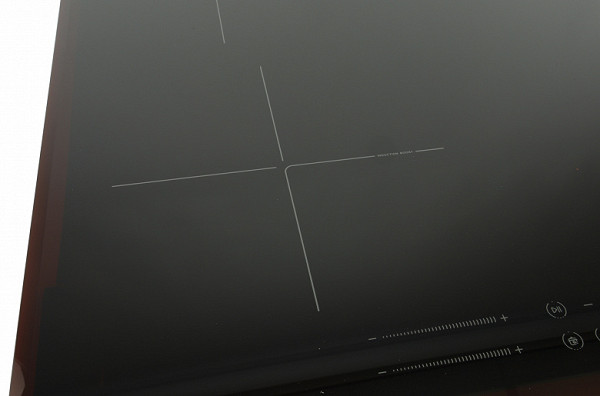
The dimensions of the burners make it easy to determine their power: the left near one is the most powerful, with a maximum power of 2300 W in normal mode and 3000 W in Boost mode; the right near and far left ones are 1200/1500 W; the far right one is 1800/2100 W. These data are specified in the documentation, and we will check their accuracy in the section with measurements.
The glass thickness is 4 mm. When installing the panel in the countertop, you should attach the complete damper tape around the perimeter from the bottom.

The casing on the bottom of the device is made of plastic and reinforced with metal inserts around the perimeter, which have holes for the mounting brackets included in the kit. The total thickness of the structure together with the glass is about 5.5 cm.

On the bottom side there is a pair of round fans, a cable outlet without a plug and a sticker with technical information.
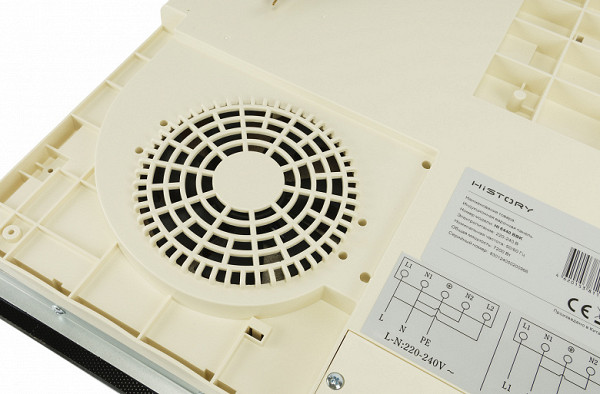
The length of the power cable is 1 meter. The device is connected to a single-phase power supply network with parameters 220-240 V, 50/60 Hz.
Instructions
The hob comes with an instruction manual in the form of a 43-page brochure printed on high-quality glossy paper.
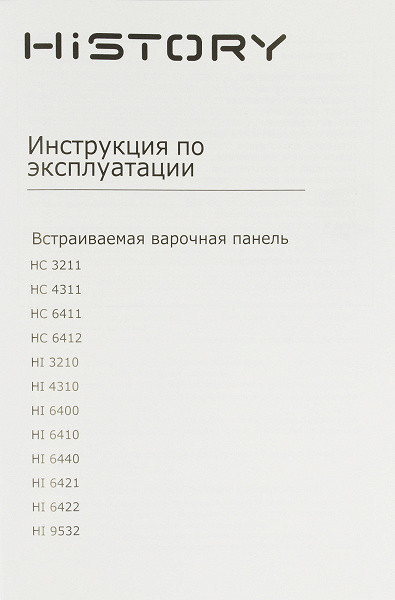
The document is compiled for 12 models of stoves at once. This makes the perception of information a little more difficult, but overall it is not difficult to understand.
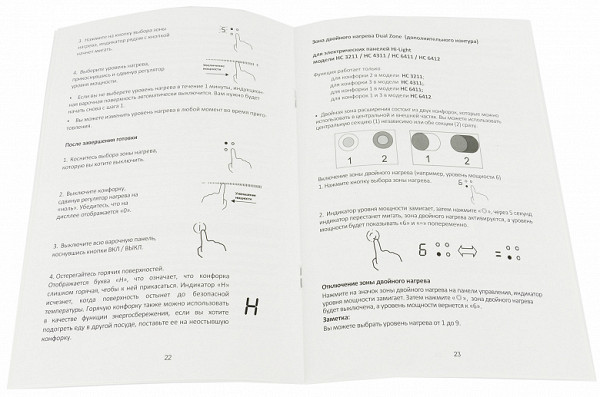
The text contains detailed information about the device, its operation, safety precautions, control and correct installation. At the end there are tips on how to eliminate possible problems without having to contact the service department, and the last page is dedicated to the warranty card.
Control

The History HI 6440 BBK touch control panel includes 7 buttons and 4 sliders — one for each heating zone. Next to each slider is an indicator showing the current power. After cooking is complete, the letter H is displayed instead of a number, indicating residual heat until the glass cools down and the indicator goes out.
The power button is located in the center, closer to the outer edge of the panel. After activating it, you can select the power of the burners from 1 to 9 and, if necessary, turn on the Boost mode, which increases the power of the heating zone to the maximum for 5 minutes. After that, the power is automatically reduced to 9. Boost mode can be activated simultaneously on three zones.
The timer in this model can be used in two ways: as a reminder that does not interrupt the operation of the heating zone, and to automatically turn off one zone after the set time, while the other burners continue to work. The maximum time for setting the timer is 99 minutes.
The second button on the right in the bottom row is used to activate the panel lock function. The leftmost button in the top row is the Stop&Go sensor, which pauses the operation of all heating zones simultaneously, saving the set parameters. To resume operation, simply press this button again. If this is not done within 30 minutes, the stove will automatically turn off.

In addition to standard functions such as timer, lock and pause, this model offers several unique options.
Smart Zone (the button to the left of Boost) automatically detects which cooking zones the cookware is placed on. If there are containers on several cooking zones, the function will recognize them all, but the temperature will need to be set one by one. The question remains as to how much easier this makes the user's job, since you can simply select the desired cooking zone using the slider and set the power with one touch. The logical placement of the sliders makes their identification simple and intuitive.
Fondue/Keep Warm mode allows you to keep food warm, as well as melt chocolate or butter. The results of this mode are described in the practical tests section below.
The Cookware Quality function, designated by the letters EE, shows the energy efficiency of the hob depending on the quality and size of the cookware. This option is really useful and has not been seen in our tests before.
For safety, the stove is automatically switched off after a set time. This is important to consider when cooking for a long time, for example, when cooking jellied meat, which requires many hours.
| Mode | 1 | 2 | 3 | 4 | 5 | 6 | 7 | 8 | 9 |
|---|---|---|---|---|---|---|---|---|---|
| Shutdown time (hours) | 8 | 8 | 8 | 4 | 4 | 4 | 2 | 2 | 2 |
Operation
The hob turned out to be easy to operate. The controls, although complicated at first glance, become intuitive after a short study of the instructions and several preparations. To start working, you only need two actions: turn on the hob and select the power by touching the corresponding slider. The power level changes smoothly and predictably, the sensors work quickly and accurately.
The special Fondue mode demonstrated excellent results, especially for pastry chefs and those who often cook dishes at low power. This function is also useful for keeping already cooked food warm.
The dimensions and location of the heating zones are optimal, which allows you to use cookware of different sizes at the same time. The photo shows containers with a diameter of 20 cm and two 24 cm.
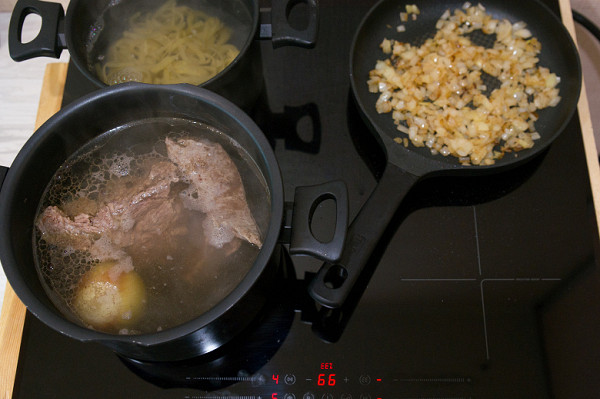
The results of frying products on each burner were satisfactory, the process was uniform.
We also tested the Cookware Quality function. For this, we used 24 cm diameter containers on each burner and obtained the following results:
80% 66%
60% 80%
We observed maximum efficiency when using 26 cm diameter cookware, where the indicator showed 99% on any burner.
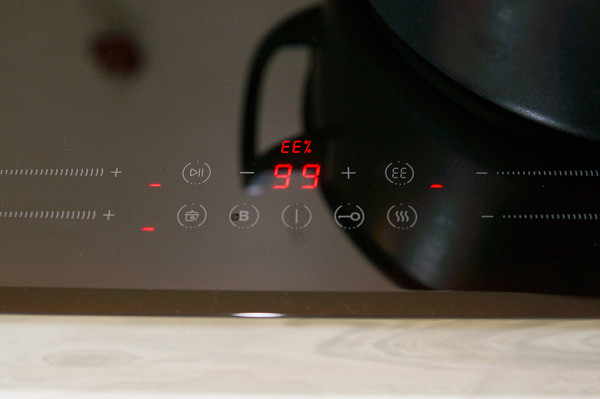
When using multiple burners, the indicator displays the arithmetic mean value.
Care
To remove dirt from the panel, it is recommended to wait until it has cooled down completely after each use. Cleaning is not difficult, since stubborn dirt usually does not stick to the glass-ceramic surface of the induction panel. Usually, a mild glass-ceramic cleaner and a damp cloth or paper towel are sufficient. If necessary, you can use a special scraper. Hard sponges, abrasive materials and chemically aggressive substances cannot be used.
Our measurements
Boiling 1 liter of water at 20°C
On the large burner in Boost mode, in a saucepan with the lid closed, 1 liter of water at 20 °C boiled in 4 minutes 55 seconds. Energy consumption was 0.145 kW h.
Power consumption in different modes
When setting the power from 1 to 6 (far left burner — from 1 to 5), all burners operate in pulse mode, switching the emitter on and off at different power levels. The duration of the on/off cycles is indicated in the table. The average power is calculated using the formula: power consumption × total duration of switching on / (total duration of switching on + total duration of pauses). For measuring the maximum power, we used cookware with a diameter of 26 cm.
Please note that the power consumption depends on the voltage in the network. In Russia, despite the standard voltage of 230 volts, which is currently accepted, in a number of places, including our office, there is still a voltage of 220 volts, inherited from Soviet times. Therefore, the results of our measurements may differ from the data specified in the manufacturer's documentation, which could have taken measurements at 230 volts. If the results seem underestimated, multiply them by 1.045 to account for the differences.
| Power mode | Power consumption, W | Cycle (off/on), s | Average power consumption, W |
|---|---|---|---|
| Near left burner (2300/3000 W) | |||
| 1 | 11.9 | 8—2—8—2 | 2.4 |
| 2 | 11.9 | 8—3—8—3 | 3.2 |
| 3 | 1120 | 6-4-6-4 | 784 |
| 4 | 1498 | 3—7—3—7 | 1048 |
| 5 | 1502 | 2—8—2—8 | 1201 |
| 6 | 1498 | 1—8—1—8 | 1331 |
| 7 | 1490 | 1490 | |
| 8 | 2004 | 2004 | |
| 9 | 2236 | 2236 | |
| Boost | 3040 | 3040 | |
| Far left burner (1200/1500 W) | |||
| 1 | 12.3 | 4—5—4—5 | 6.8 |
| 2 | 725 | 4—5—4—5 | 402 |
| 3 | 1078 | 3—6—3—6 | 718 |
| 4 | 1094 | 2—8—2—8 | 875 |
| 5 | 1080 | 1—8—1—8 | 960 |
| 6 | 1085 | 1085 | |
| 7 | 1090 | 1090 | |
| 8 | 1155 | 1155 | |
| 9 | 1310 | 1310 | |
| Boost | 1559 | 1559 | |
| Near right burner (1200/1500 W) | |||
| 1 | 9.2 | 9—2—9—2 | 1.7 |
| 2 | 598 | 8—3—8—3 | 163 |
| 3 | 780 | 6-5-6-5 | 354 |
| 4 | 794 | 5—6—5—6 | 433 |
| 5 | 813 | 3—7—3—7 | 569 |
| 6 | 822 | 2—8—2—8 | 657 |
| 7 | 804 | 804 | |
| 8 | 920 | 920 | |
| 9 | 1190 | 1190 | |
| Boost | 1453 | 1453 | |
| Far right burner (1800/2100 W) | |||
| 1 | 12.2 | 4—5—4—5 | 6.8 |
| 2 | 707 | 4—5—4—5 | 392 |
| 3 | 1112 | 3—6—3—6 | 741 |
| 4 | 1199 | 2—8—2—8 | 959 |
| 5 | 1205 | 1—8—1—8 | 1071 |
| 6 | 1205 | 1—9—1—9 | 1084 |
| 7 | 1415 | 1415 | |
| 8 | 1560 | 1560 | |
| 9 | 1790 | 1790 | |
| Boost | 1856 | 1856 |
Heating element size
To determine the size of the heating elements, we placed a large container with a small amount of water on the stove. After a few seconds, the bubbles at the bottom of the water indicated the configuration of the heating element: a circle with smooth edges and no internal void.
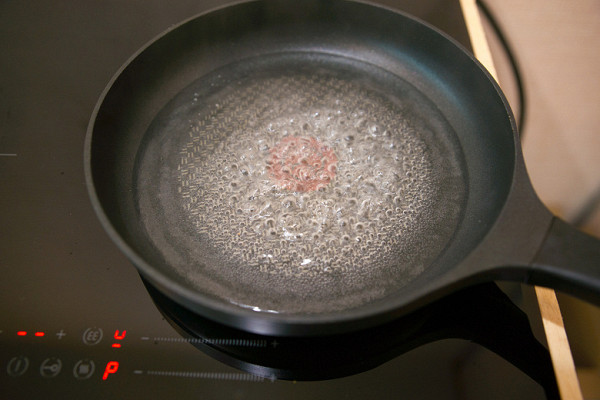
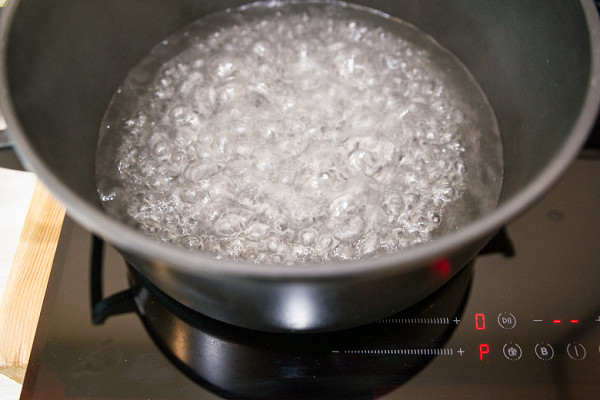
In Boost mode, the circle diameter was:
| 19 cm | 19 cm |
| 21 cm | 18 cm |
In other modes, the diameter was smaller by an average of 1-2 cm.
Other measurements
The hob's power consumption when switched off is 0.5 W. Switched on but without active burners, the hob consumes 8.9 W, and with the burners switched off but the fans running — 12.7 W.
For almost 3 hours of cooking soup and pasta using three burners, the total energy consumption was 2.667 kWh, with a maximum power of 3404 W.
In Fondue mode, the maximum power was 13.6 W, and the energy consumption for 13 minutes of operation was 0.011 kWh.
Our wattmeter cannot correctly measure consumption above 4000 W, so we were unable to record the maximum consumption when using all burners at the same time. However, based on measurements at maximum power without Boost for each of the four cooking zones with a 26 cm diameter pan, the total consumption is: 2236 + 1310 + 1190 + 1790 = 6526 W. With the Boost function turned on, the consumption is: 2773 + 1559 + 1453 + 1856 = 7641 W. However, this power cannot be achieved simultaneously, since Boost can only be activated on three cooking zones at a time.
The fan noise was rated as average: it is noticeable, but not overly annoying.
Practice tests
Kharcho
Ingredients: beef — 800 g, rice — 150 g, tomatoes — 300 ml, one medium onion, walnuts — 120 g, vegetable oil, salt, black peppercorns, hops-suneli, adjika — 1 tbsp., tkemali — 1 tbsp., several cloves of garlic, a bunch of cilantro or parsley
First of all, in this test we are interested in the ability of the hob to maintain a low temperature for a long time and stably.

To make the broth, we used 800 g of boneless beef, which we poured into four liters of cold water, added salt, allspice peas, and one large peeled onion. We turned on the Boost mode, then switched to power level 9 and brought the contents of the pan to a boil in 15 minutes.
After skimming off the foam, we reduced the heat to level 5 and placed the temperature probe in the broth. During the first 40 minutes, the temperature was maintained within the range of 88-90 °C. Later, it rose to 95 °C, so we reduced the heat to level 4, after which the temperature stabilized again at 90 °C. To fully cook the meat, the broth simmered for almost two hours, while there were no significant fluctuations in the liquid temperature.
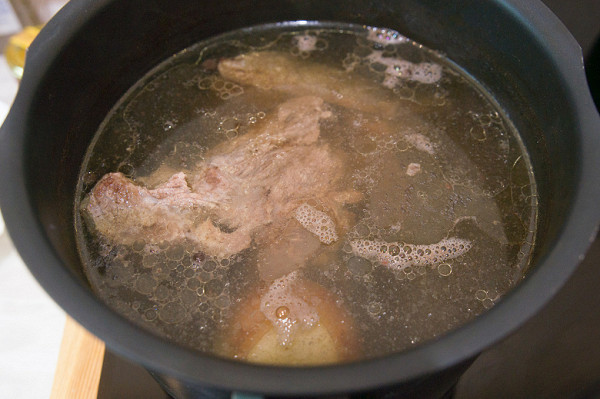
The broth turned out to be aromatic and rich. We added chopped dry herbs to it and moved on to preparing the remaining ingredients.

Fry the onion, then add canned diced tomatoes without skin in their own juice and a few crushed cloves of garlic. Season the contents of the pan with a generous portion of khmeli-suneli, add salt, stir and leave to simmer under the lid at power level 5.
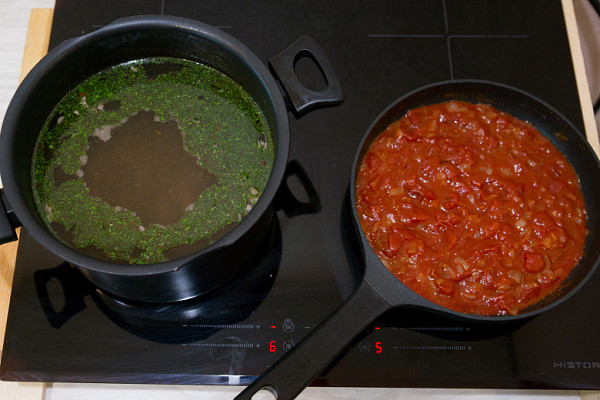
Meanwhile, we took the cooked meat out of the pot, cut it up and put it back into the hot broth. We added the tomato mixture from the frying pan, a tablespoon of adjika, tkemali, a handful of chopped walnuts and pre-washed rice. We mixed and cooked at the 7th power level for exactly 10 minutes. Then we turned off the stove and left the soup under a tightly closed lid for about an hour. Although it would have been better to leave it longer, we did not have enough patience — the aroma was incredible, and the taste was the same.
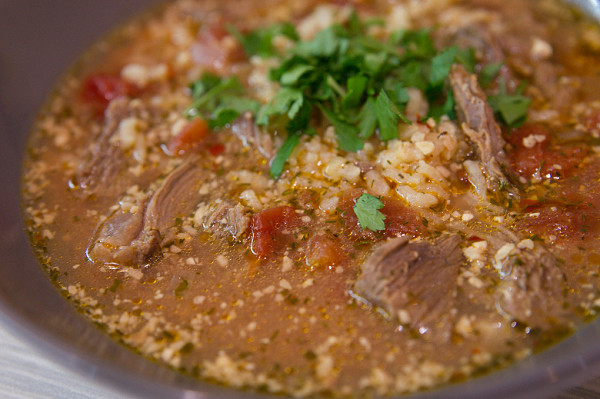
Result: excellent
Pasta with chicken and mushrooms in a creamy sauce
Ingredients: tagliatelle pasta — 400 g, chicken breast — 300 g, champignons — 300 g, one small onion, cream 33% — 200 ml, hard cheese — 100 g, olive oil for frying, salt and ground black pepper — to taste
At the same time as the soup, we started cooking the pasta. At power 9, we fried chicken fillet pieces with champignons in hot oil.

Then add finely chopped onion. Later pour in cream, add grated cheese, some salt and pepper, crushed garlic and simmer on level 4 with the lid closed for about 15 minutes.
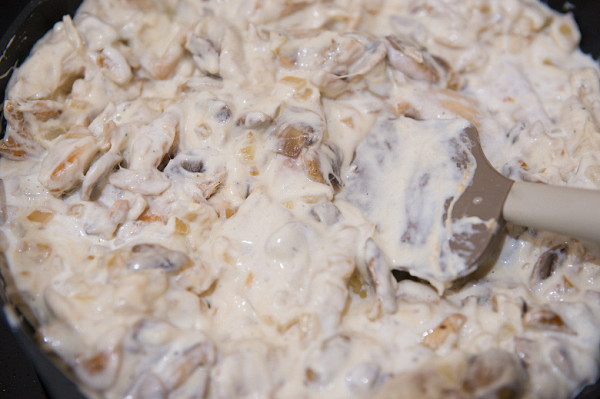
During this time, the pasta was cooked on the adjacent burner. We returned the chicken to the pan, put the pasta in it and stirred. We covered it with a lid and heated it on the 6th level for 5 minutes.
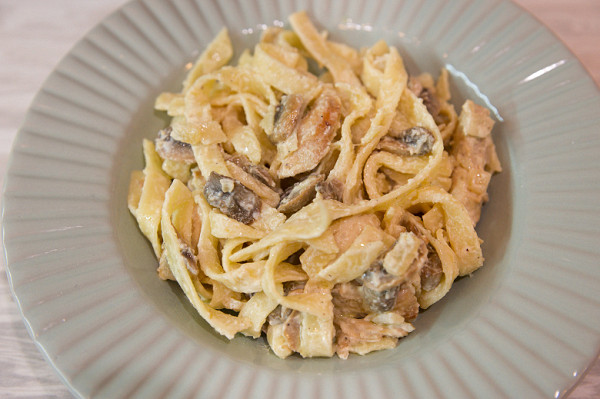
Result: excellent
Steak
A room temperature beef steak was fried in a hot frying pan on the largest and, as we found out during measurements, the most powerful heating zone.
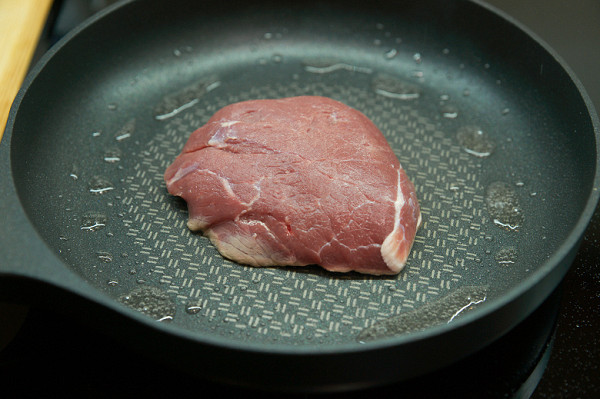
Turning occasionally, we fried the meat on both sides first in Boost mode, and after a golden crust appeared, we reduced the heat to 8. In total, it took about 5 minutes.

We put the steak on a plate, sprinkled it generously on both sides with black pepper and salt. Covered it with foil and left it to rest for about 5 minutes. This is how we got a juicy, tasty steak, medium rare.

Result: excellent
Frozen pancakes

First, we placed the pancakes straight from the freezer in a frying pan and heated them up at power level 4. Then we increased the power to 6 and fried them on both sides until golden brown. The whole process took about 10 minutes.
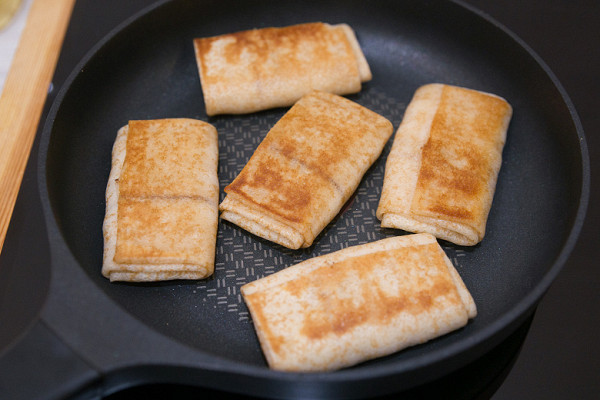
The cottage cheese filling was well heated, and the frying was even — the pancake did not burn in the center and did not remain pale at the edges. There was no need to change the pancakes during the process.
Result: excellent
Melted chocolate
Place 70 g of dark chocolate with 75% cocoa content on the bottom of a thick-bottomed frying pan and turn on the Fondue mode.

We did not interfere with the process and simply observed. In 13 minutes, without preheating the container, the chocolate melted evenly, without lumps, and did not burn. The temperature of the bottom of the container fluctuated between 38 and 43°C.
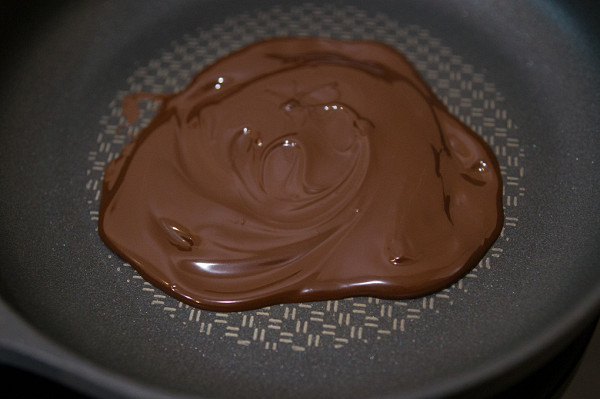
Result: excellent
Conclusions
History HI 6440 BBK proved itself as an excellent induction panel. It successfully coped with all our tests and did not cause any complaints. The built-in surface easily copes with everyday tasks, has convenient touch control and a set of functions that greatly simplify operation.
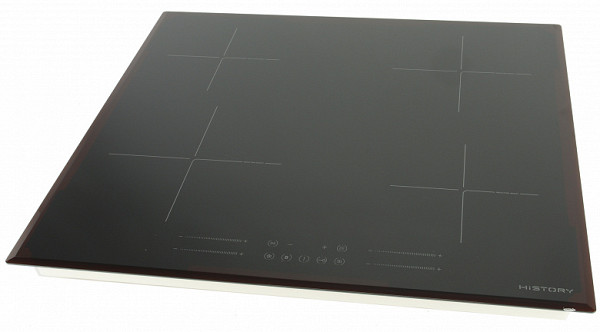
The cooker effectively maintains low temperatures and includes a special Fondue mode for gentle heating. It also quickly and evenly fries food at maximum power, which was confirmed during testing. The size of the heating elements ensures even frying, which is a rare advantage. Another plus is the mode for assessing the efficiency of energy consumption depending on the quality and size of the cookware.
Pros:
- high power
- wide range of temperature adjustments
- convenient control and ease of maintenance
- set of useful and well-implemented functions
Cons:
- non-switchable sound signals


